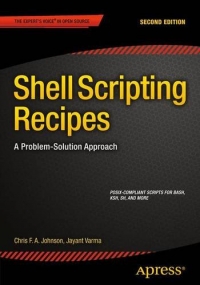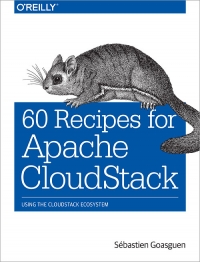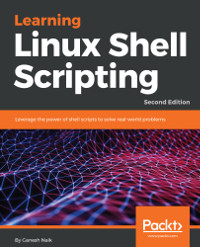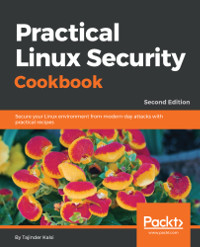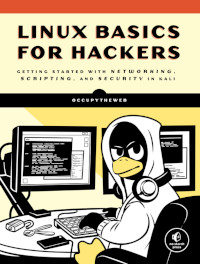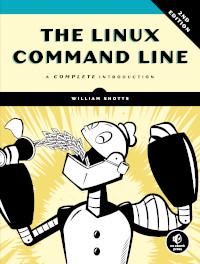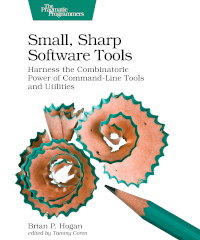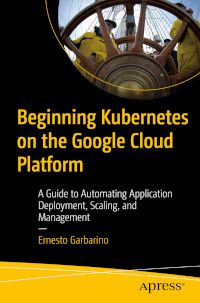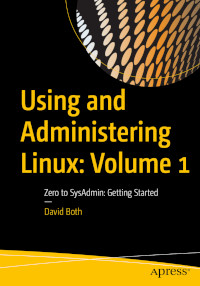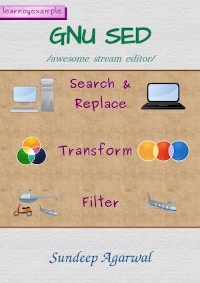Shell Scripting Recipes, 2nd Edition
Shell Scripting Recipes is filled with over 150 much-needed and practical recipes that follow a problem-solution format, and help all Unix users regain some of the lost time spent creating and testing shell scripts. Most scripts in this book are POSIX (Portable Operating System Interface)-compliant, so they are supported by many of the major shell variants, including Bash, ksh, and sh, among others. This completely updated second edition takes into account the many changes to shell scripting that have occurred since its original publication nearly ten years ago, and all the recipes are now relevant for a modern audience. Each real-world example recipe follows the same structure and easily shows you what's going on in each case. File conversion (DOS, UNIX, and Mac), system administration, and resource monitoring are just a few of the topics covered in this highly practical shell scripting reference. You will also find recipes for filename management, complex date calculations, screen ...
Shell Scripting Recipes is filled with over 150 much-needed and practical recipes that follow a problem-solution format, and help all Unix users regain some of the lost time spent creating and testing shell scripts. Most scripts in this book are POSIX (Portable Operating System Interface)-compliant, so they are supported by many of the major shell variants, including Bash, ksh, and sh, among others. This completely updated second edition takes into account the many changes to shell scripting that have occurred since its original publication nearly ten years ago, and all the recipes are now relevant for a modern audience. Each real-world example recipe follows the same structure and easily shows you what's going on in each case. File conversion (DOS, UNIX, and Mac), system administration, and resource monitoring are just a few of the topics covered in this highly practical shell scripting reference. You will also find recipes for filename management, complex date calculations, screen ...
60 Recipes for Apache CloudStack
Planning to deploy and maintain a public, private, or hybrid cloud service? This cookbook's handy how-to recipes help you quickly learn and install Apache CloudStack, along with several API clients, API wrappers, data architectures, and configuration management technologies that work as part of CloudStack's ecosystem. You'll learn how to use Vagrant, Ansible, Chef, Fluentd, Libcloud, and several other open source tools that let you build and operate CloudStack better and faster. If you're an experienced programmer, system administrator, or DevOps practitioner familiar with bash, Git, package management, and some Python, you're ready to go. ...
Planning to deploy and maintain a public, private, or hybrid cloud service? This cookbook's handy how-to recipes help you quickly learn and install Apache CloudStack, along with several API clients, API wrappers, data architectures, and configuration management technologies that work as part of CloudStack's ecosystem. You'll learn how to use Vagrant, Ansible, Chef, Fluentd, Libcloud, and several other open source tools that let you build and operate CloudStack better and faster. If you're an experienced programmer, system administrator, or DevOps practitioner familiar with bash, Git, package management, and some Python, you're ready to go. ...
Learning Linux Shell Scripting, 2nd Edition
Linux is the most powerful and universally adopted OS. Shell is a program that gives the user direct interaction with the operating system. Scripts are collections of commands that are stored in a file. The shell reads this file and acts on commands as if they were typed on the keyboard. Learning Linux Shell Scripting covers Bash, GNU Bourne Again Shell, preparing you to work in the exciting world of Linux shell scripting. CentOS is a popular rpm-based stable and secured Linux distribution. Therefore, we have used CentOS distribution instead of Ubuntu distribution. Linux Shell Scripting is independent of Linux distributions, but we have covered both types of distros. We start with an introduction to the Shell environment and basic commands used. Next, we explore process management in Linux OS, real-world essentials such as debugging and perform Shell arithmetic fluently. You'll then take a step ahead and learn new and advanced topics in Shell scripting, such as decision making, star ...
Linux is the most powerful and universally adopted OS. Shell is a program that gives the user direct interaction with the operating system. Scripts are collections of commands that are stored in a file. The shell reads this file and acts on commands as if they were typed on the keyboard. Learning Linux Shell Scripting covers Bash, GNU Bourne Again Shell, preparing you to work in the exciting world of Linux shell scripting. CentOS is a popular rpm-based stable and secured Linux distribution. Therefore, we have used CentOS distribution instead of Ubuntu distribution. Linux Shell Scripting is independent of Linux distributions, but we have covered both types of distros. We start with an introduction to the Shell environment and basic commands used. Next, we explore process management in Linux OS, real-world essentials such as debugging and perform Shell arithmetic fluently. You'll then take a step ahead and learn new and advanced topics in Shell scripting, such as decision making, star ...
Practical Linux Security Cookbook, 2nd Edition
Over the last few years, system security has gained a lot of momentum and software professionals are focusing heavily on it. Linux is often treated as a highly secure operating system. However, the reality is that Linux has its share of security aws, and these security aws allow attackers to get into your system and modify or even destroy your important data. But there's no need to panic, since there are various mechanisms by which these aws can be removed, and this book will help you learn about different types of Linux security to create a more secure Linux system. With a step-by-step recipe approach, the book starts by introducing you to various threats to Linux systems. Then, this book will walk you through customizing the Linux kernel and securing local files. Next, you will move on to managing user authentication both locally and remotely and mitigating network attacks. Later, you will learn about application security and kernel vulnerabilities. You will also learn about patch ...
Over the last few years, system security has gained a lot of momentum and software professionals are focusing heavily on it. Linux is often treated as a highly secure operating system. However, the reality is that Linux has its share of security aws, and these security aws allow attackers to get into your system and modify or even destroy your important data. But there's no need to panic, since there are various mechanisms by which these aws can be removed, and this book will help you learn about different types of Linux security to create a more secure Linux system. With a step-by-step recipe approach, the book starts by introducing you to various threats to Linux systems. Then, this book will walk you through customizing the Linux kernel and securing local files. Next, you will move on to managing user authentication both locally and remotely and mitigating network attacks. Later, you will learn about application security and kernel vulnerabilities. You will also learn about patch ...
Linux Basics for Hackers
If you're getting started along the exciting path of hacking, cybersecurity, and pentesting, Linux Basics for Hackers is an excellent first step. Using Kali Linux, an advanced penetration testing distribution of Linux, you'll learn the basics of using the Linux operating system and acquire the tools and techniques you'll need to take control of a Linux environment. First, you'll learn how to install Kali on a virtual machine and get an introduction to basic Linux concepts. Next, you'll tackle broader Linux topics like manipulating text, controlling file and directory permissions, and managing user environment variables. You'll then focus in on foundational hacking concepts like security and anonymity and learn scripting skills with bash and Python. Practical tutorials and exercises throughout will reinforce and test your skills as you learn how to: Cover your tracks by changing your network information and manipulating the rsyslog logging utility; Write a tool to scan for network co ...
If you're getting started along the exciting path of hacking, cybersecurity, and pentesting, Linux Basics for Hackers is an excellent first step. Using Kali Linux, an advanced penetration testing distribution of Linux, you'll learn the basics of using the Linux operating system and acquire the tools and techniques you'll need to take control of a Linux environment. First, you'll learn how to install Kali on a virtual machine and get an introduction to basic Linux concepts. Next, you'll tackle broader Linux topics like manipulating text, controlling file and directory permissions, and managing user environment variables. You'll then focus in on foundational hacking concepts like security and anonymity and learn scripting skills with bash and Python. Practical tutorials and exercises throughout will reinforce and test your skills as you learn how to: Cover your tracks by changing your network information and manipulating the rsyslog logging utility; Write a tool to scan for network co ...
The Linux Command Line, 2nd Edition
The Linux Command Line takes you from your very first terminal keystrokes to writing full programs in Bash, the most popular Linux shell (or command line). Along the way you'll learn the timeless skills handed down by generations of experienced, mouse-shunning gurus: file navigation, environment configuration, command chaining, pattern matching with regular expressions, and more. In addition to that practical knowledge, author William Shotts reveals the philosophy behind these tools and the rich heritage that your desktop Linux machine has inherited from Unix supercomputers of yore. As you make your way through the book's short, easily-digestible chapters, you'll learn how to: Create and delete files, directories, and symlinks; Administer your system, including networking, package installation, and process management; Use standard input and output, redirection, and pipelines; Edit files with Vi, the world's most popular text editor; Write shell scripts to automate common or borin ...
The Linux Command Line takes you from your very first terminal keystrokes to writing full programs in Bash, the most popular Linux shell (or command line). Along the way you'll learn the timeless skills handed down by generations of experienced, mouse-shunning gurus: file navigation, environment configuration, command chaining, pattern matching with regular expressions, and more. In addition to that practical knowledge, author William Shotts reveals the philosophy behind these tools and the rich heritage that your desktop Linux machine has inherited from Unix supercomputers of yore. As you make your way through the book's short, easily-digestible chapters, you'll learn how to: Create and delete files, directories, and symlinks; Administer your system, including networking, package installation, and process management; Use standard input and output, redirection, and pipelines; Edit files with Vi, the world's most popular text editor; Write shell scripts to automate common or borin ...
Small, Sharp Software Tools
The command-line interface is making a comeback. That's because developers know that all the best features of your operating system are hidden behind a user interface designed to help average people use the computer. But you're not the average user, and the CLI is the most efficient way to get work done fast. Turn tedious chores into quick tasks: read and write files, manage complex directory hierarchies, perform network diagnostics, download files, work with APIs, and combine individual programs to create your own workflows. Put down that mouse, open the CLI, and take control of your software development environment. No matter what language or platform you're using, you can use the CLI to create projects, run servers, and manage files. You can even create new tools that fit right in with grep, sed, awk, and xargs. You'll work with the Bash shell and the most common command-line utilities available on macOS, Windows 10, and many flavors of Linux. Create files without opening a te ...
The command-line interface is making a comeback. That's because developers know that all the best features of your operating system are hidden behind a user interface designed to help average people use the computer. But you're not the average user, and the CLI is the most efficient way to get work done fast. Turn tedious chores into quick tasks: read and write files, manage complex directory hierarchies, perform network diagnostics, download files, work with APIs, and combine individual programs to create your own workflows. Put down that mouse, open the CLI, and take control of your software development environment. No matter what language or platform you're using, you can use the CLI to create projects, run servers, and manage files. You can even create new tools that fit right in with grep, sed, awk, and xargs. You'll work with the Bash shell and the most common command-line utilities available on macOS, Windows 10, and many flavors of Linux. Create files without opening a te ...
Beginning Kubernetes on the Google Cloud Platform
Use this beginner's guide to understand and work with Kubernetes on the Google Cloud Platform and go from single monolithic Pods (the smallest unit deployed and managed by Kubernetes) all the way up to distributed, fault-tolerant stateful backing stores. You need only a familiarity with Linux, Bash, and Python to successfully use this book. Proficiency in Docker or cloud technology is not required. You will follow a learn-by-doing approach, running small experiments and observing the effects. Google open sourced Kubernetes in 2015 and now it is the industry standard in container orchestration. It has been adopted by all leading vendors of cloud, on-prem, and hybrid infrastructure services: Microsoft (Azure AKS), Amazon (AWS EKS), IBM (IBM Cloud Kubernetes Services), Alibaba Cloud (ACK), RedHat (OpenShift), and Pivotal (PKS). Even though Kubernetes is offered by all of the market-leading cloud providers, the Google Cloud Platform (GCP) offers an integrated shell (Google Cloud Shell) ...
Use this beginner's guide to understand and work with Kubernetes on the Google Cloud Platform and go from single monolithic Pods (the smallest unit deployed and managed by Kubernetes) all the way up to distributed, fault-tolerant stateful backing stores. You need only a familiarity with Linux, Bash, and Python to successfully use this book. Proficiency in Docker or cloud technology is not required. You will follow a learn-by-doing approach, running small experiments and observing the effects. Google open sourced Kubernetes in 2015 and now it is the industry standard in container orchestration. It has been adopted by all leading vendors of cloud, on-prem, and hybrid infrastructure services: Microsoft (Azure AKS), Amazon (AWS EKS), IBM (IBM Cloud Kubernetes Services), Alibaba Cloud (ACK), RedHat (OpenShift), and Pivotal (PKS). Even though Kubernetes is offered by all of the market-leading cloud providers, the Google Cloud Platform (GCP) offers an integrated shell (Google Cloud Shell) ...
Using and Administering Linux: Volume 1
Become a Linux sysadmin and expert user of Linux, even with no previous Linux experience and learn to manage complex systems with ease. Volume 1 of this three volume training course introduces operating systems in general and Linux in particular. It briefly explores the The Linux Philosophy for SysAdmins in preparation for the rest of the course. This book provides you with the tools necessary for mastering user management; installing, updating, and deleting software; and using command line tools to do performance tuning and basic problem determination. You'll begin by creating a virtual network and installing an instance of Fedora - a popular and powerful Linux distribution - on a VirtualBox VM that can be used for all of the experiments on an existing Windows or Linux computer. You'll then move on to the basics of using the Xfce GUI desktop and the many tools Linux provides for working on the command line including virtual consoles, various terminal emulators, BASH, and other shel ...
Become a Linux sysadmin and expert user of Linux, even with no previous Linux experience and learn to manage complex systems with ease. Volume 1 of this three volume training course introduces operating systems in general and Linux in particular. It briefly explores the The Linux Philosophy for SysAdmins in preparation for the rest of the course. This book provides you with the tools necessary for mastering user management; installing, updating, and deleting software; and using command line tools to do performance tuning and basic problem determination. You'll begin by creating a virtual network and installing an instance of Fedora - a popular and powerful Linux distribution - on a VirtualBox VM that can be used for all of the experiments on an existing Windows or Linux computer. You'll then move on to the basics of using the Xfce GUI desktop and the many tools Linux provides for working on the command line including virtual consoles, various terminal emulators, BASH, and other shel ...
GNU SED
The book heavily leans on examples to present features of sed as well as regular expressions one by one. It is recommended that you manually type each example and experiment with them. Understanding both the nature of sample input string and the output produced is essential. You should have prior experience working with command line and bash shell, should know concepts like file redirection, command pipeline and so on. ...
The book heavily leans on examples to present features of sed as well as regular expressions one by one. It is recommended that you manually type each example and experiment with them. Understanding both the nature of sample input string and the output produced is essential. You should have prior experience working with command line and bash shell, should know concepts like file redirection, command pipeline and so on. ...
